Are you finding yourself tossing and turning in the middle of the night, unable to stay asleep? Or maybe you’ve always struggled with falling asleep, but now it’s taking hours instead of 30 minutes for shut-eye to kick in.
With a high-stress environment caused by the pandemic, the US presidential election and a world constantly evolving with debates and quarantine rules, it’s no wonder why many people are suffering from insomnia.
The definition of insomnia is “persistent difficulty with sleep initiation, duration, consolidation or quality,” according to the American Academy of Sleep Medicine. I know this battle all too well. Prior to becoming a certified yoga instructor and health coach, I had my own struggles with insomnia and was on sleep medication.
Determined to change my habits and improve my sleep, I took up a yoga class on a whim after a recommendation from a friend. It was a weekly class that focused on slow, deep breathing; self-acceptance; and connecting breath with movement.
After two months of doing the class, I no longer needed my sleeping medication to fall asleep. It was as if my insomnia was cured, so to speak. It has been almost 20 years since I started my yoga practice. Insomnia, however, has crept its way back at different points in my life. This reminds me to recommit to my yoga practice and deep breathing, as I had experienced its transformative results firsthand.
In fact, a regular yoga routine helps with not only insomnia but also improved total sleep time and sleep efficiency, according to research.
Perhaps you’re a skeptic on yoga, or you don’t know where to begin. I designed this insomnia yoga routine just for you to focus on poses that bring inward calm to your nervous system and allow your body to relax. Whether you do this routine right before bed, during the day or in the morning, a regular practice is what’s most important in order to help with insomnia.
Breathwork and mindfulness is also a major part of this yoga routine. Breathing in through the nose and out through the nose helps calm the nervous system. As you hold each yoga pose, think of breathing in and filling your body up with air, and breathing out to release deeper into the pose. This mindful attention to your body and to your breath, studies have shown, helps improve sleep, too.
READ MORE: Reduce back pain with this 5-minute home workout
Mountain pose
This pose allows you to start by feeling grounded and centered with the breath. It connects you to the Earth, aligns your spine and allows your body to ease into the start of the yoga practice.
Standing with your feet as wide as your hips, press down evenly through all 10 toes and squeeze your quadriceps (the large muscle at the front of each thigh) to engage your legs. Pull your naval in toward your spine. Roll your shoulders back, and allow the arms to dangle down by your sides with the shoulders externally rotated. Open the palms to face forward.
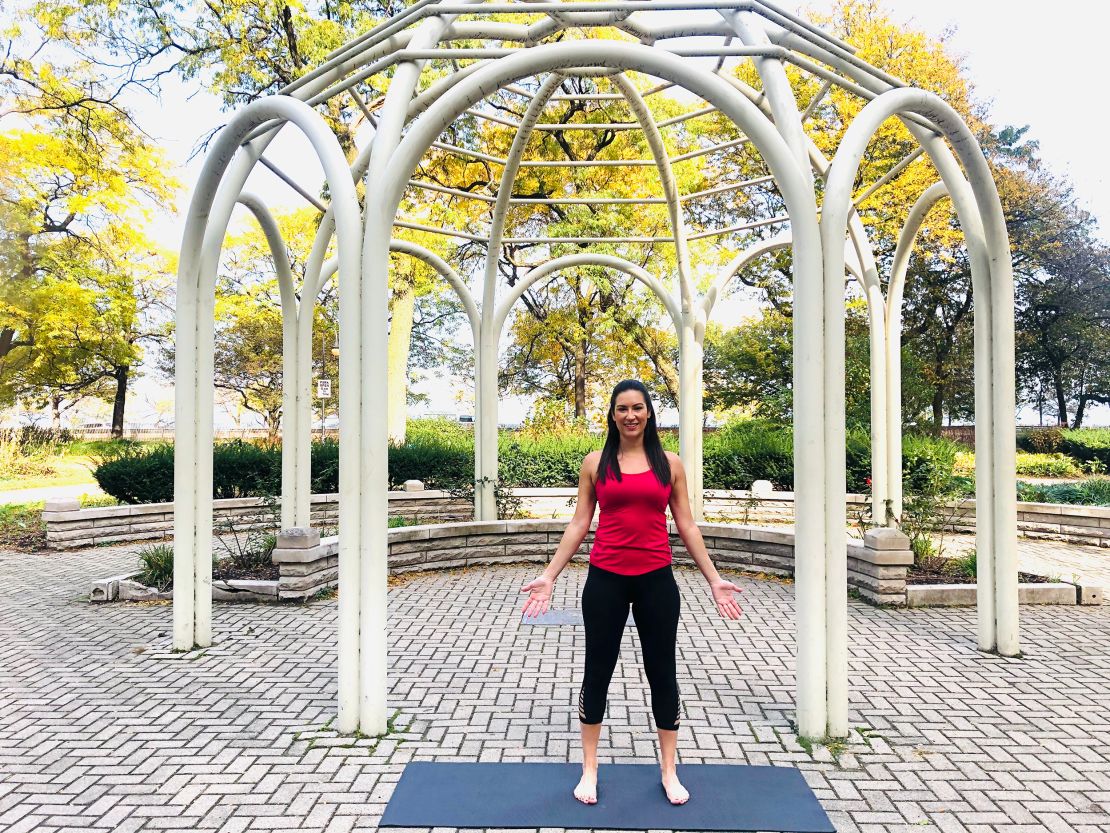
Bring the chin back so that the upper back is straight. Relax the shoulders. Take five slow, deep breaths breathing in through the nose and out through the nose. Fill up the belly and then the chest as you inhale, and release the chest then the belly as you exhale.
Forward fold clasping opposite elbows
This pose has a calming effect on the nervous system because it places your body in a position that is inward-focused. Holding on to opposite elbows also provides traction for your shoulders and neck to help relieve tension in the upper body.
Stand with your feet as wide as your hips, place your hands on your hips and slowly hinge forward at your waist. Allow your arms to dangle down, and then hold on to opposite elbows with your head in the center.
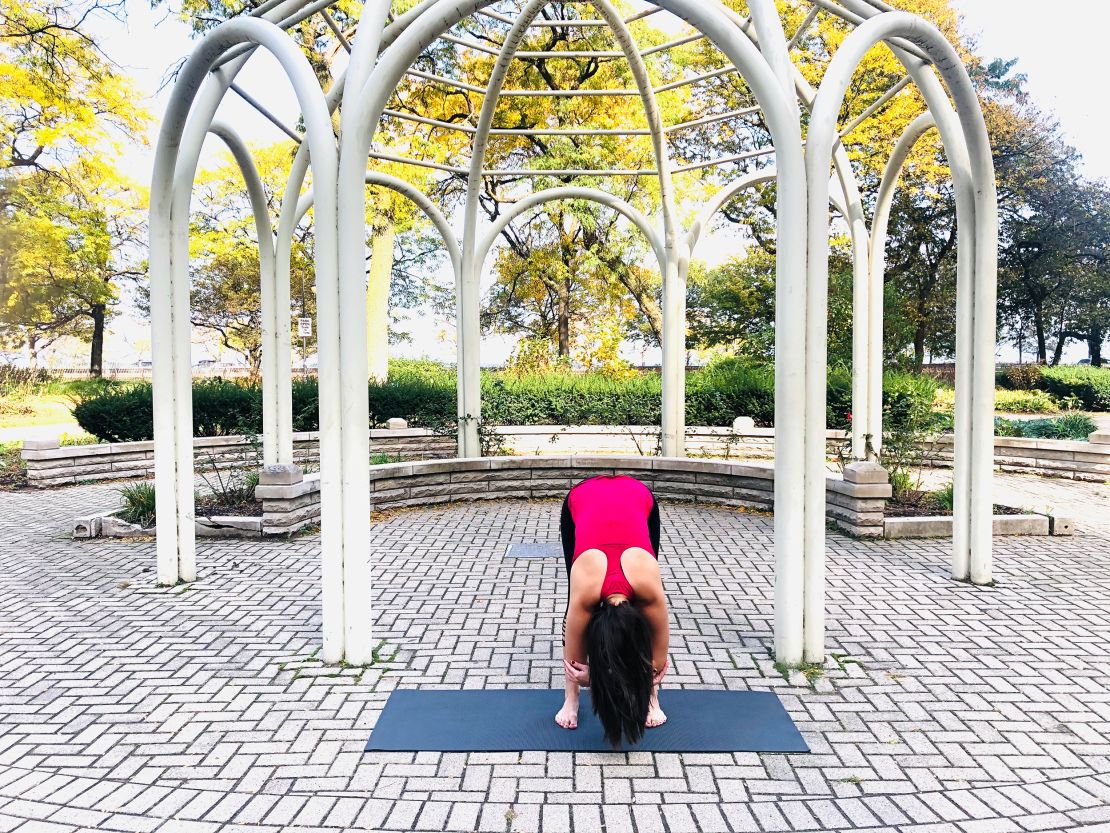
Slowly shake your head yes and no, and press the weight evenly down through both feet. Hold for five deep breaths, and then release the arms down and slowly roll up to standing.
READ MORE: This 5-minute meditation routine will calm you down
Triangle pose
This pose opens up the inner thighs and groin which can become tight and stiff after working from home in awkward positions. This pose also opens up the side waist and low back. A tight low back and inner thighs contribute to hip and back pain that can cause you to stay up at night.
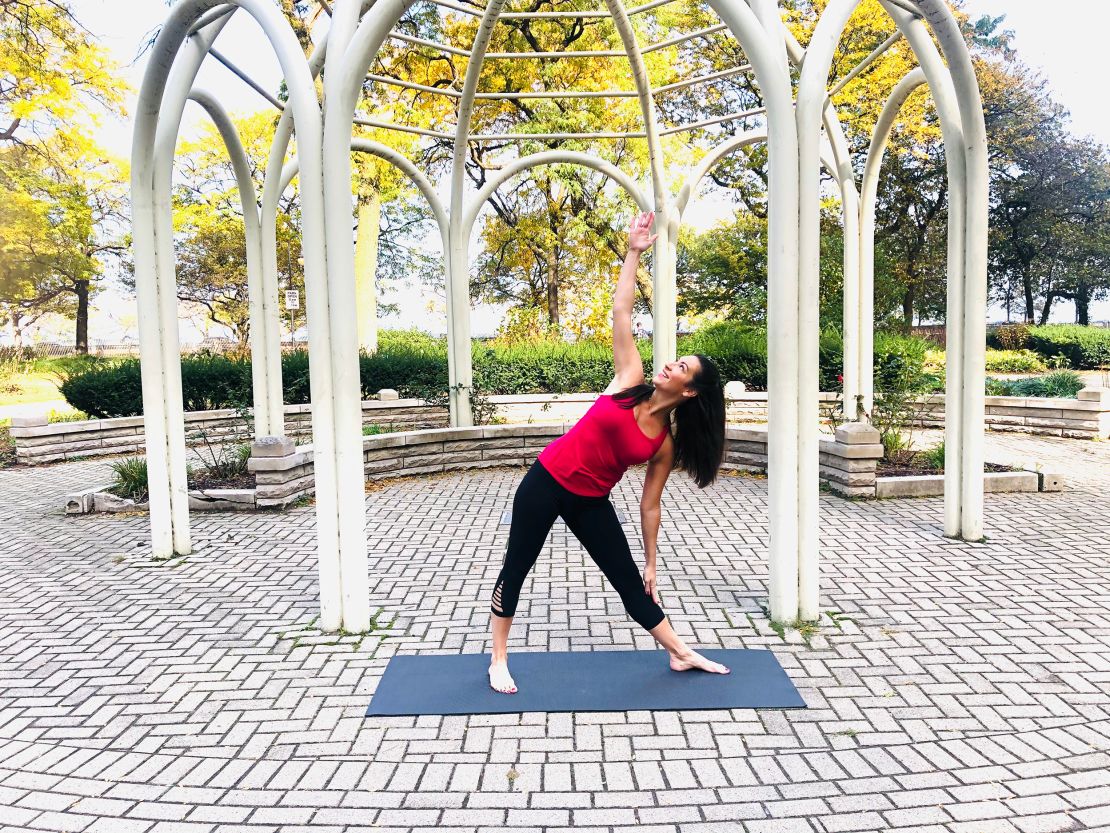
Step the feet out wider than the shoulders, and turn the left foot in at a 45 degree angle so that the toes are facing toward the front corner of the mat. Turn the right foot so that it points straight to the right edge of the mat with the right heel lined up with the arch of the left foot. Open the arms out to the sides, and turn to look over the right fingertips.
Hinge forward with the right hand, and then lower the right hand down toward the right shin. Feel a stretch on the left side waist. Press down evenly through both feet and open the shoulders so that they are stacked on top of each other. Hold for three breaths, and then come up to the starting position.
Turn the feet to repeat on the left side.
Crescent lunge
Tight hip flexors also contribute to low back pain which can keep you awake at night. By opening up the hips in a low lunge position, your body will feel more relaxed without feeling overly energized. This is a great pose if you’re sedentary or sitting all day as the hip flexors get tight from being in a cramped position throughout the day.
Step your right foot forward and your left foot back. Lower the left knee onto the ground underneath the left hip. Bend the right knee over the right ankle. Reach the arms up towards the sky, relax the shoulders, pull the naval in toward the spine, and breathe for five slow breaths.
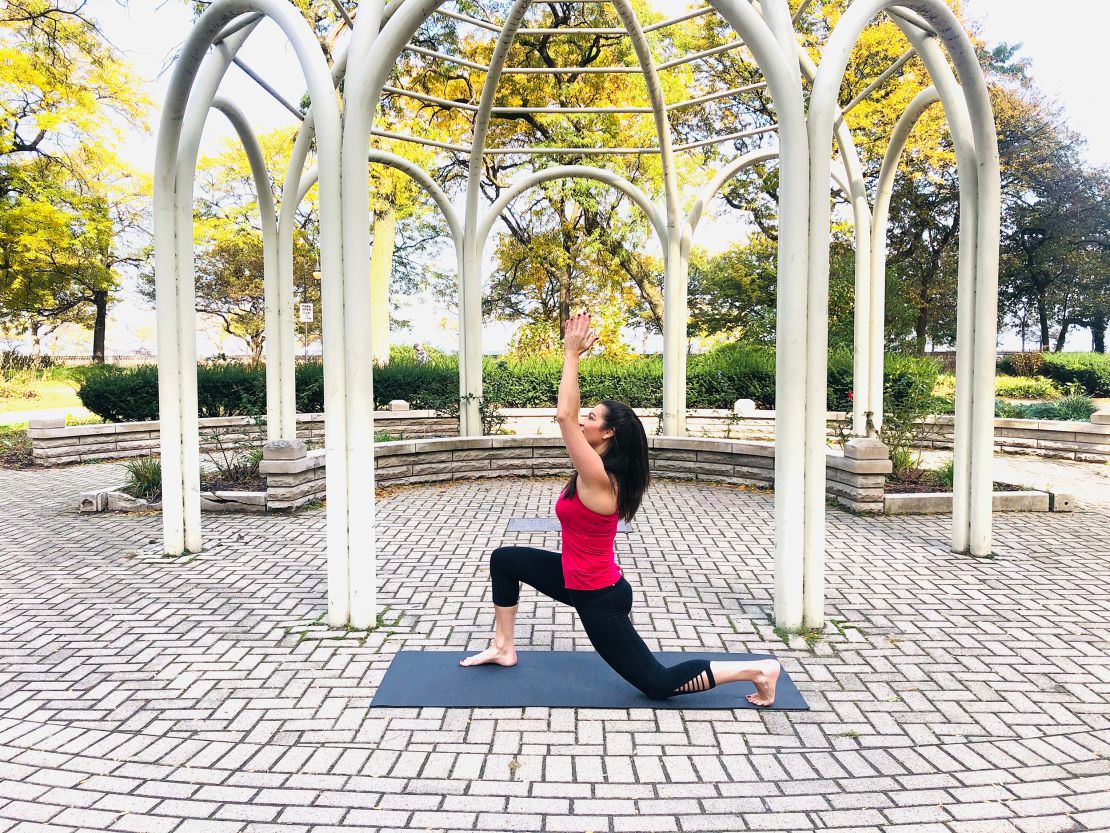
Release the arms down, and turn around to face the opposite side of the mat and repeat with the left foot forward.
READ MORE: Improve your balance: A 5-minute home workout for stability and focus
Wide-leg forward fold
This is another inward-facing pose, with your head positioned below your waist and the back of the legs being stretched. This has a soothing effect on the nervous system. Stretching the back of the body also helps relieve tension from the neck all the way down the spine and down the back of the legs.
Open your arms out wide and then step your feet out as wide as your wrists. Be sure to point the toes forward. Hinge forward at your waist and allow your arms to dangle down in front of you and then place the palms of your hands down flat on the mat. Release the chin toward the chest.
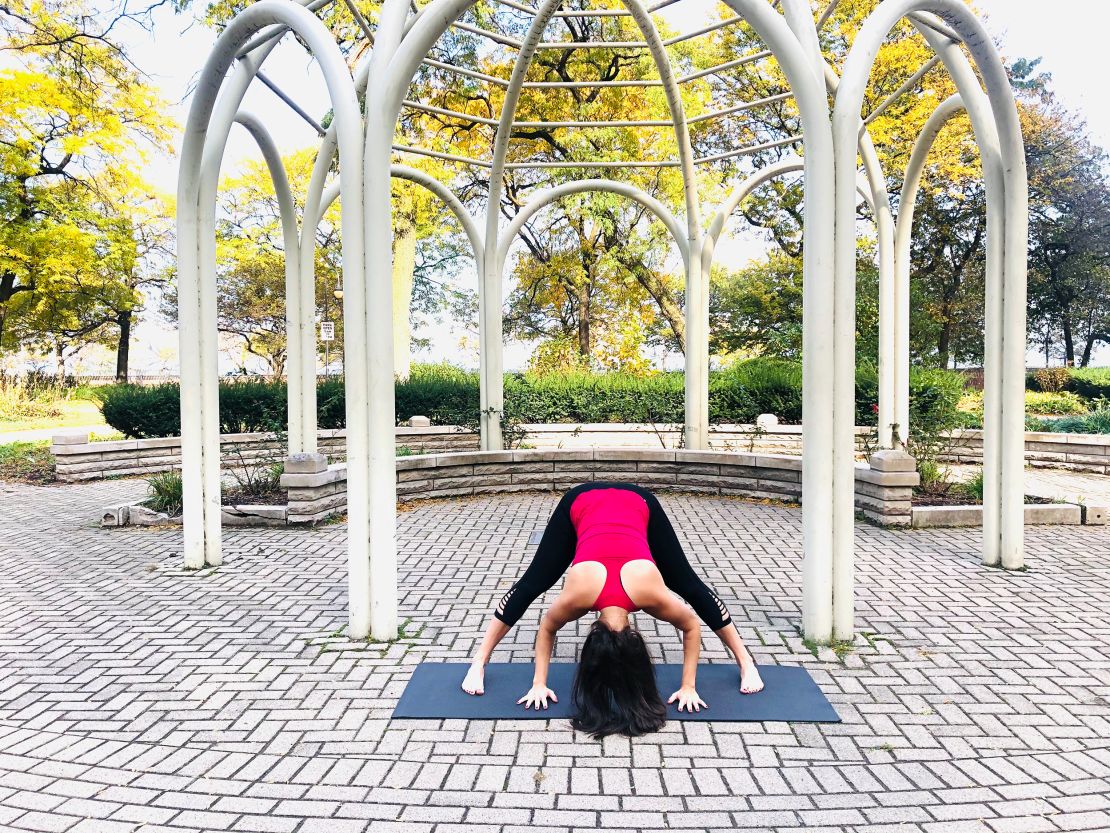
Hold this for five deep breaths, and then slowly come up to standing by pressing down through your feet.
Standing pigeon pose
Another forward fold, this pose aids in winding down the mind, body and nervous system and also stretches one of the largest muscles in the body: the glutes.
Standing with your feet as wide as your hips and balance on your left leg as you lift your right leg up and cross your right ankle over your left knee. Bend the left knee and place your hands together at the center of your chest. Relax the shoulders. Flex the right foot and slowly lean forward over the legs only as far as is comfortable for you.
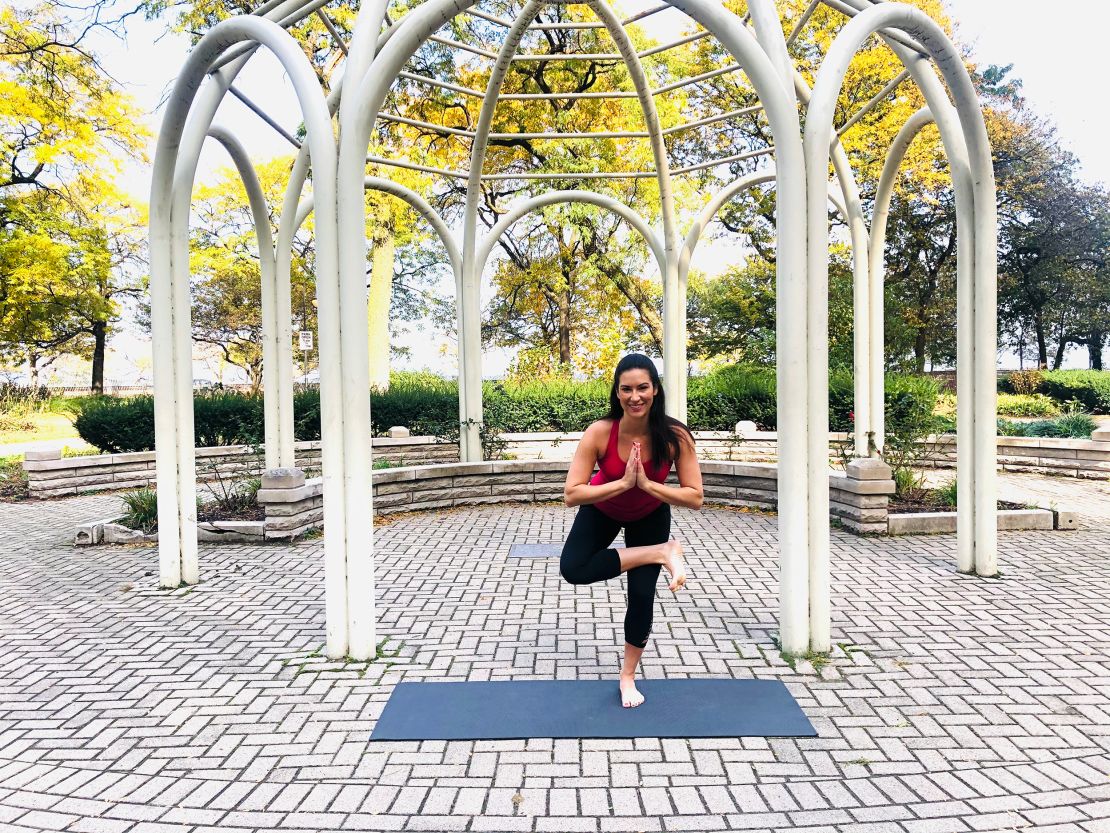
Hold for three deep breaths, and then slowly stand up and release. Repeat on the other side.
Flow through this sequence at any point in the day. While doing yoga before bed can help wind down the nervous system, performing this sequence at any point throughout the day will have a calming effect on the body and aid in your body’s ability to wind down when it’s time for bed.
If you have days when you’re not in the mood to unroll your yoga mat, switch things up with our five-minute yoga routine that can be done in bed! Both of these routines will go a long way toward helping you wind down for more peaceful slumber.
Sign up for our CNN’s Sleep, But Better Newsletter to get better sleep.
Stephanie Mansour, host of “Step It Up With Steph” on PBS, is a health and wellness journalist and a consultant and weight loss coach for women.

